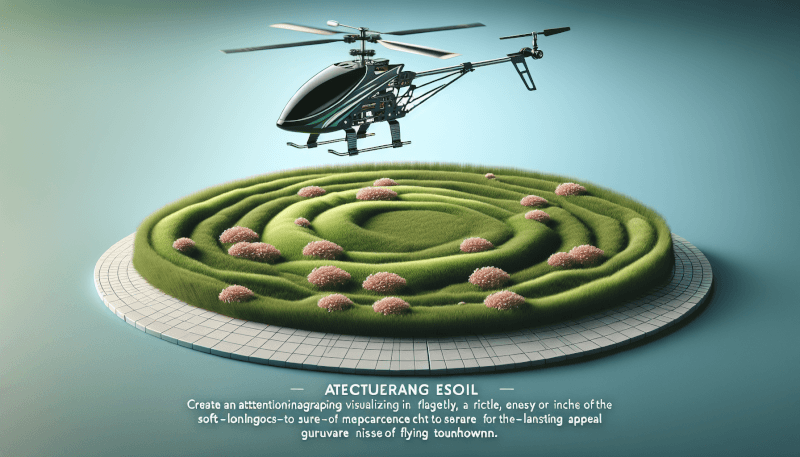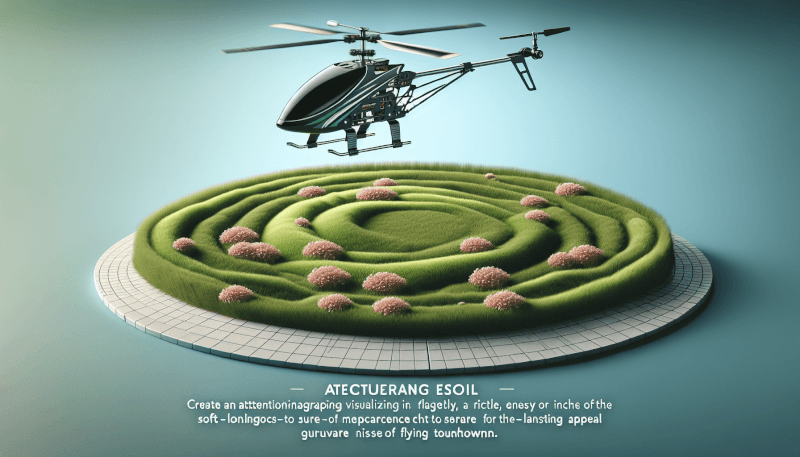Imagine the exhilaration of flying your RC heli through the air, effortlessly maneuvering between obstacles and performing stunning aerial tricks. However, as any experienced pilot knows, the landing can often be the most challenging part. In this article, we will explore some simple and effective techniques that will help you safely land your RC heli without causing any damage. Whether you are a beginner or a seasoned pilot, these tips will ensure a smooth and controlled landing every time, maximizing the longevity of your beloved RC heli. So, let’s dive right in and master the art of a safe landing together!
Choosing the Right Landing Zone
Assess the area for potential hazards
Before attempting to land your RC heli, it is crucial to assess the landing zone for any potential hazards. Look out for trees, power lines, or any other obstructions that could interfere with a safe landing. Clear the area of any debris or loose objects that could potentially damage the heli during touchdown. By carefully evaluating the landing zone, you can minimize the risk of accidents and ensure a smooth landing.
Check for level ground
When choosing a landing zone for your RC heli, it is essential to find a spot with level ground. Uneven surfaces can make it challenging to maintain control during the landing process, leading to a higher risk of damage to your heli. Take the time to find a suitable area that provides a smooth and level surface, allowing for a stable landing.
Consider the size and space requirements
The size and space requirements of the landing zone should also be taken into consideration. Ensure that the area is large enough to accommodate the size and maneuverability of your RC heli. This will allow for a safe and controlled landing without any restrictions or limitations. Consider factors such as the heli’s rotor span and any space needed for takeoff and landing maneuvers.
Preparing for Landing
Slow down and reduce altitude gradually
As you prepare for landing, it is crucial to slow down and reduce altitude gradually. Abruptly dropping the heli or descending too quickly can lead to an unstable landing and potential damage. Use the controls to gently decrease the collective pitch and adjust the throttle to slow down the heli’s speed. This controlled approach will ensure a smooth descent and minimize the risk of any mishaps.
Position the heli for landing
Before initiating the descent, position the RC heli for landing. Make sure you have a clear line of sight to the landing zone and adjust the heli’s orientation to align with the desired landing spot. Taking the time to position the heli correctly will help maintain control and ensure a precise landing.
Take into account wind direction and speed
It is essential to factor in the wind direction and speed when preparing for landing. Strong winds can significantly affect the stability of your RC heli during landing. Take note of the wind’s direction and adjust your approach accordingly to compensate for any crosswinds. By accounting for wind conditions, you can execute a controlled landing with minimal turbulence.

Executing a Controlled Landing
Maintain a stable approach
During the landing process, it is crucial to maintain a stable approach. This means controlling your heli’s speed, maintaining a consistent trajectory, and avoiding sudden changes in direction. A stable approach provides better control and reduces the chances of a hard landing that could cause damage to the heli.
Keep a steady descent rate
Maintaining a steady and controlled descent rate is key to a safe landing. Avoid rapid or jerky movements that can lead to an unstable descent or even cause the heli to lose control. Use small adjustments to control the descent rate and ensure a smooth and gradual touchdown.
Monitor rotor speed and pitch
As you execute the landing, keep a close eye on the rotor speed and pitch. Ensure that the rotor speed is appropriate for a controlled landing and adjust it if necessary. Additionally, monitor the pitch of the main rotor blades to maintain stability during the descent. Proper monitoring of these factors plays a crucial role in landing your RC heli safely.
Avoiding Common Landing Mistakes
Avoid excessive collective inputs
One common mistake during landing is applying excessive collective inputs. The collective pitch controls the heli’s vertical movement, and using too much can cause the heli to drop abruptly or lose control. Be mindful of your collective inputs and make gradual adjustments to avoid unnecessary strain on the heli and ensure a smooth landing.
Watch out for tail strikes
Tail strikes occur when the tail of the heli hits the ground, causing damage to the tail rotor and potentially destabilizing the aircraft. To avoid this, it is essential to maintain proper control and awareness of the heli’s orientation during landing. Keep the tail elevated slightly to prevent it from making contact with the landing surface.
Prevent tip-overs during touchdown
A common landing mistake is allowing the heli to tip over during touchdown. This can happen if the skids or landing gear are not properly aligned or if the heli lands at an angle. To prevent tip-overs, ensure that the skids or landing gear are level and parallel to the ground. Maintain control and adjust the heli’s positioning as needed during the landing process to ensure a stable touchdown.

Handling Emergency Situations
Dealing with loss of power
In the event of a loss of power during a landing, it is crucial to remain calm and act quickly. Reduce the collective pitch to minimize the heli’s descent rate and attempt an autorotation, which uses the airflow through the rotor blades to maintain control. Practice autorotations beforehand to familiarize yourself with the procedure and increase your chances of a successful emergency landing.
Handling mechanical failures
Mechanical failures can occur unexpectedly, posing a challenge during landing. If you encounter a mechanical issue, such as a servo failure or motor malfunction, prioritize safety and take immediate action to land the heli. Lower the collective pitch to reduce the heli’s descent rate and attempt to maneuver it to a safe landing spot. Each mechanical failure may present unique challenges, so it is essential to be prepared and remain calm in such situations.
Responding to signal loss
Signal loss between your RC transmitter and the heli can be a stressful situation during landing. In such cases, it is crucial to remain focused and follow the standard procedures for signal loss recovery. Reduce collective pitch, maintain control, and attempt to regain the signal. If signal recovery is unsuccessful, prepare for an emergency landing by slowly reducing altitude and maneuvering the heli to a safe area away from people and obstacles.
Performing Maintenance Checks
Inspect rotor blades before and after flights
Regularly inspecting your rotor blades is essential for ensuring safe landings and a longer lifespan for your RC heli. Before and after each flight, carefully examine the blades for any signs of damage, such as cracks, chips, or loose fittings. Ensure that they are securely attached and balanced. If any issues are detected, address them before flying again to prevent potential issues during landing.
Check for loose or damaged parts
As part of routine maintenance, regularly check for loose or damaged parts on your RC heli. This includes inspecting the landing gear, skids, main rotor head, and tail components. Loose or damaged parts can compromise the stability and safety of your landings. Tighten any loose fittings and replace any damaged or worn-out components promptly to maintain optimal performance.
Ensure proper battery health
A well-functioning battery is vital for safe landings and overall flight performance. Prior to every flight, ensure that your battery is fully charged and in good condition. Monitor the battery voltage and take note of any unusual fluctuations or signs of degradation. Replace old or damaged batteries to prevent unexpected power losses during landing.

Using Landing Gear Effectively
Understanding the purpose of landing gear
The landing gear on your RC heli serves the crucial role of providing stability and protecting the aircraft during landings. It absorbs the impact upon touchdown and helps maintain balance. Familiarize yourself with the design and function of the landing gear on your specific model to ensure proper usage and effectiveness.
Installing and adjusting landing skids
Proper installation and adjustment of landing skids are essential for safe landings. Refer to the manual provided by the manufacturer for specific instructions on installation. Ensure that the skids are securely attached and parallel to the ground to prevent tip-overs and ensure stability during landings. Regularly inspect and maintain the landing skids to ensure their continued effectiveness.
Choosing appropriate landing gear materials
When selecting landing gear for your RC heli, consider the materials used and their suitability for your flying environment. Landing gear is commonly made of materials like plastic, carbon fiber, or metal. Each material has its advantages and disadvantages in terms of durability, weight, and shock absorption. Choose landing gear that best suits your needs and provides optimal protection during landings.
Considering Environmental Factors
Accounting for temperature and humidity
Temperature and humidity levels can affect the performance and stability of your RC heli during landings. Extreme temperatures or high humidity can impact battery performance and motor efficiency. It is important to monitor these environmental factors and adjust your landing strategy accordingly. Be mindful of any potential risks or limitations imposed by hot or humid conditions.
Avoiding wet or unstable surfaces
Wet or unstable surfaces pose a significant risk during landings. Landing your RC heli on wet grass or mud can cause the heli to lose control and potentially tip over. Prioritize landing on dry and stable surfaces whenever possible to mitigate these risks. If landing options are limited, exercise caution and make necessary adjustments to maintain control during touchdown.
Avoiding landing in windy conditions
Wind can significantly impact the stability and control of your RC heli during landing. Strong gusts or turbulent winds can make it challenging to maintain a steady descent and may even cause the heli to veer off course. Avoid landing in windy conditions whenever possible or choose a sheltered area that provides some protection from the wind. Always prioritize safety and adjust your landing plans accordingly.

Protecting the Heli During Transport
Secure the heli using proper cases or bags
When transporting your RC heli, it is essential to secure it properly to prevent damage. Invest in a sturdy and appropriately sized case or bag that provides adequate protection during transit. Ensure that the heli is securely fastened and immobilized within the case to minimize the risk of any internal or external damage.
Remove rotors or use protective covers
To further protect your RC heli during transport, consider removing the rotors or using protective covers. Rotors are the most vulnerable parts of the heli and can be easily damaged if not properly secured. Taking the extra step of removing the rotors or using protective covers adds an extra layer of protection during transit.
Avoid stacking other items on top of the heli
When transporting your RC heli, avoid stacking other items on top of it. Even lightweight objects can put unnecessary pressure and potentially damage the delicate components of the heli. Dedicate a separate space or compartment for your heli to prevent any accidental damage. Prioritize the safety of your heli during transport to ensure its longevity and performance.
Learning from Experienced Pilots
Seek advice from experienced RC heli pilots
One of the best ways to improve your landing skills and prevent damage to your RC heli is to seek advice from experienced pilots. Connect with local RC heli flying clubs or fellow enthusiasts who can provide valuable insights and guidance. Experienced pilots may share invaluable tips and techniques specific to your model or flying style, helping you become a more skilled and confident pilot.
Attend RC heli flying clubs or events
Attending RC heli flying clubs or events is a fantastic opportunity to learn from experienced pilots and connect with fellow enthusiasts. These gatherings often offer workshops or demonstrations that focus on landing techniques and safety practices. Participating in such events allows you to observe and interact with experienced pilots, enabling you to enhance your landing skills and expand your knowledge within a supportive community.
Participate in online forums and communities
Engaging in online forums and communities dedicated to RC heli enthusiasts is another great way to learn from experienced pilots. These platforms provide a wealth of information, tips, and tricks on various aspects of RC heli flying, including landing techniques. Active participation in discussions and seeking advice from knowledgeable members can help you gain valuable insights, troubleshoot landing issues, and foster connections within the RC heli community.
By following these guidelines and putting safety as a priority, you can safely and effectively land your RC heli without damaging it. Taking the time to assess the landing area, executing controlled landings, and maintaining your heli’s maintenance will ensure enjoyable and damage-free flying experiences for years to come. Remember, practice and continuous learning from experienced pilots are key to improving your landing skills and becoming a confident RC heli pilot. Happy flying!



